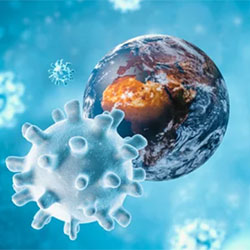By Ethan Covey
HIV diagnoses and testing rates fell strongly during the COVID-19 pandemic, and experts emphasize that cooperation between federal, state, and local healthcare providers and organizations is necessary in order to compensate for these losses and prevent negative disease impacts (MMWR Morb Mortal Wkly Rep 2022;71[25]:820-824).

“HIV testing is the first step in accessing HIV prevention and care services and is a key strategy for the Ending the HIV Epidemic in the U.S. [EHE] initiative, which aims to reduce new HIV infections by at least 90% by 2030,” Elizabeth A. DiNenno, PhD, an epidemiologist with the CDC’s Division of HIV Prevention, National Center for HIV, Viral Hepatitis, STD, and TB Prevention, told Infectious Disease Special Edition. “The COVID-19 pandemic disrupted healthcare delivery, and might have affected HIV testing.”
She said the CDC conducted this study to begin to understand the full impact of the pandemic on HIV testing.
The study’s focus was the reported number of HIV tests administered and number of positive results received during 2019-2020 by utilizing data from three sources: the Health Resources and Service Administration’s Uniform Data System, CDC’s National HIV Prevention Program Monitoring and Evaluation system, and the National Syndromic Surveillance Program’s commercial laboratory data.
Across the board, sharp decreases were found in the number of CDC-funded HIV tests administered in healthcare and non-healthcare settings (43% and 50%, respectively) from 2019 to 2020—the first year of the pandemic.
Concerning drops also were identified among groups disproportionately affected by HIV. In non-healthcare settings, where people who are tested for HIV provide information about race/ethnicity and transmission, a 49% decline was reported in HIV testing among gay and bisexual men, 47% among transgender people, 46% among Hispanic and Latino people, and 44% among Black people.
“These findings highlight the urgent need to scale up HIV testing and reduce disparities among the people who could most benefit from HIV prevention and care,” Dr. DiNenno said.
“HIV testing is the bridge to highly effective treatment and prevention,” she added. “Delayed diagnosis can lead to increased HIV transmission and negative health outcomes. We are concerned that some infections that would have been diagnosed in 2020 may not be diagnosed for several years, and a person with undiagnosed HIV will not receive the powerful benefits of rapid treatment.”
Existing CDC recommendations state that everyone between the ages of 14 and 64 years should be tested for HIV at least once, with annual rescreening of people who report behaviors that increase the chances of acquiring or transmitting HIV.
In order to compensate for HIV testing and diagnoses missed during the pandemic, the CDC is encouraging partnerships among federal organizations, state and local health departments, community-based organizations, and healthcare systems to increase access to HIV testing services.
These partnerships, Dr. DiNenno and her colleagues said, will help to reverse these trends in testing and diagnosis, ensure patients with positive HIV diagnoses are able to promptly begin post-exposure prophylaxis, and enable the United States to accelerate efforts to reach EHE goals.
Dr. DiNenno reported no relevant financial disclosures.




